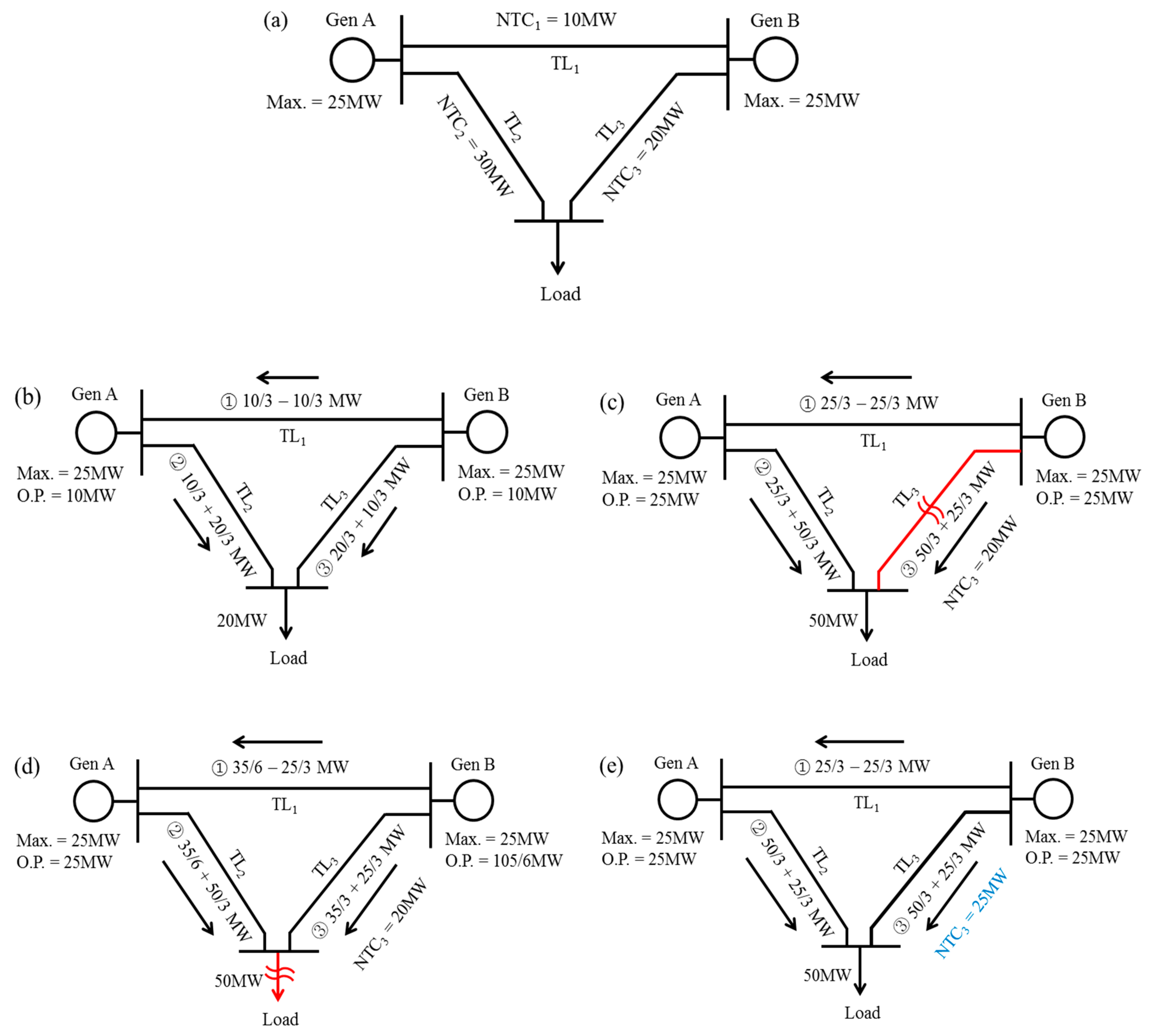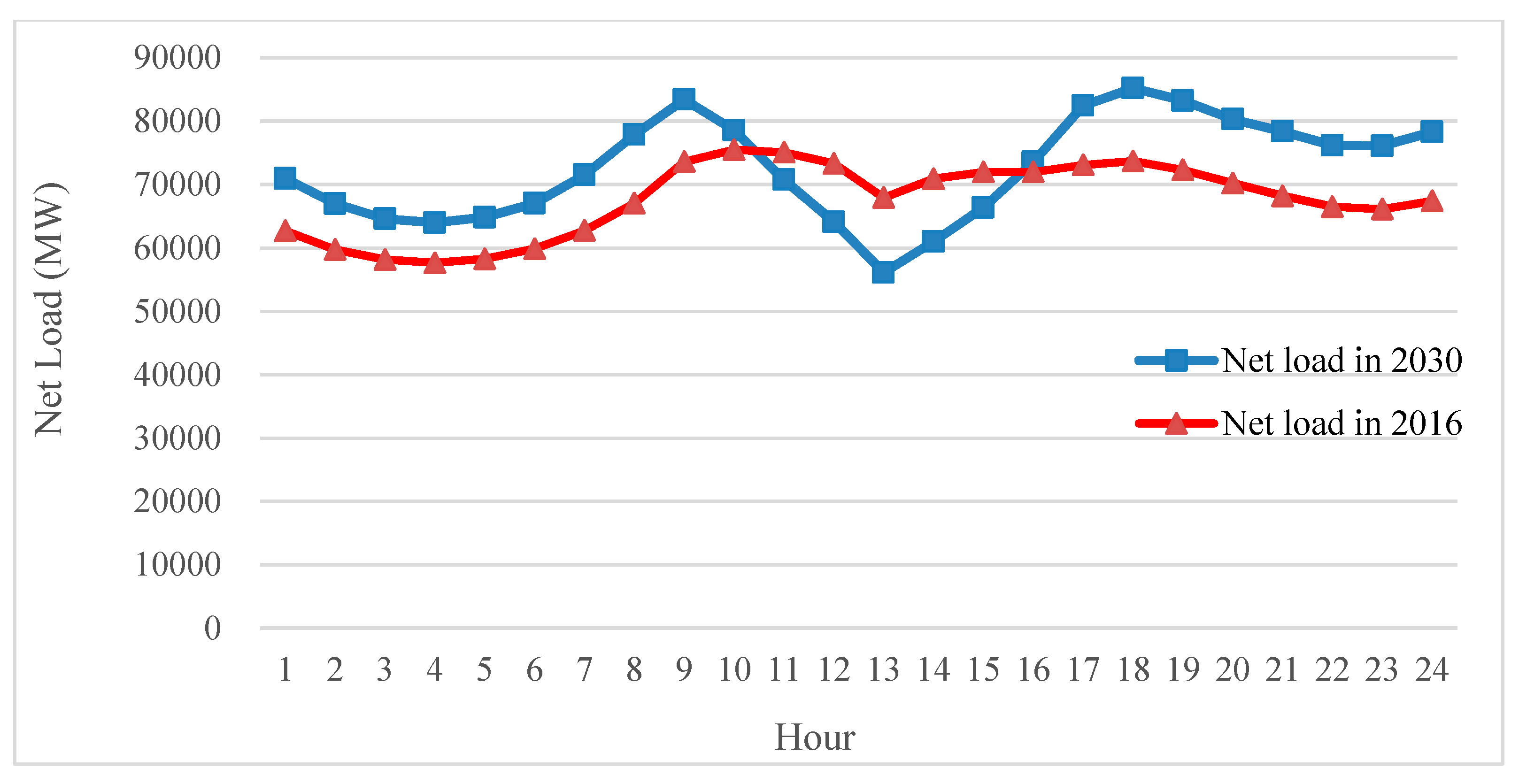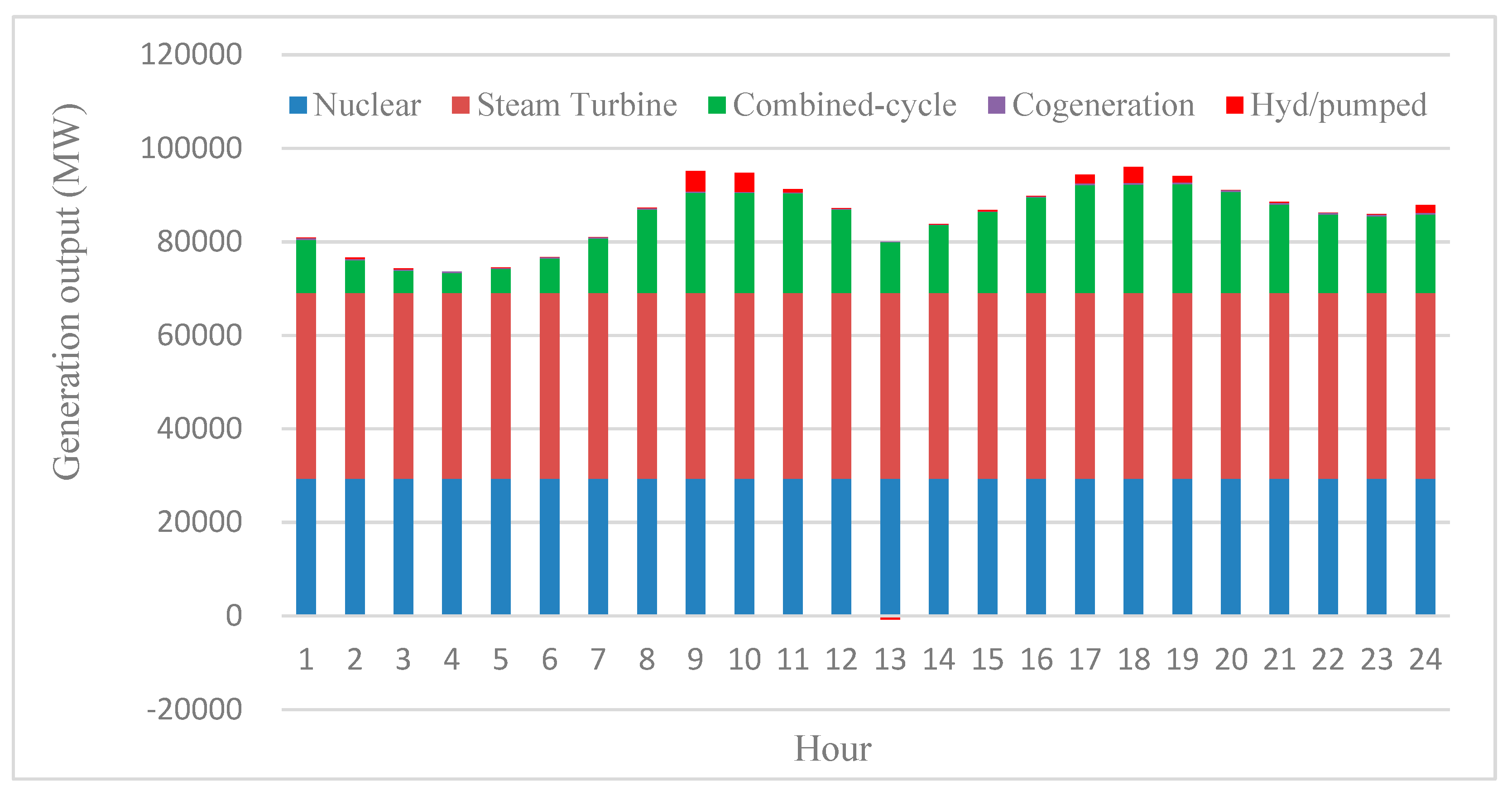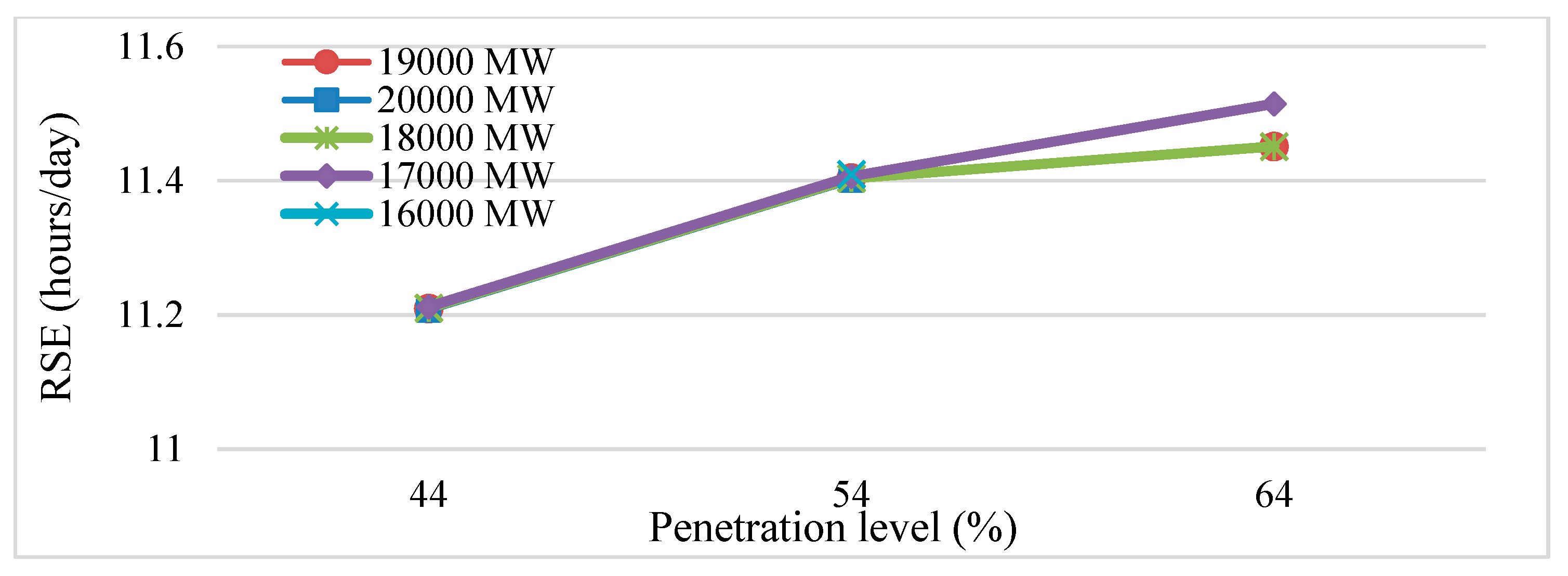Impact Analysis of Transmission Congestion on Power System Flexibility in Korea
Abstract
:1. Introduction
2. Flexibility Index: Ramping Capability Shortage Expectation
2.1. Ramping Capability Requirement and System Ramping Capability
2.2. Ramping Capability Shortage Probability and Ramping Capability Shortage Expectation
3. Scenario Generation and Evaluation for Transmission Congestion
3.1. Flexibility Restriction Due to Transmission Congestion
3.2. Scenario Generation and Evaluation of Transmission Congestion
4. Case Study
4.1. Base Scenario
4.2. Scenario Generation and Evaluation
5. Conclusions
Author Contributions
Funding
Conflicts of Interest
Nomenclature
| Ai,t | Random variable representing availability of generator i at time t (1 if available, 0 otherwise) |
| b | Index of base scenario |
| c | Element of Ct−Δt |
| Ct-Δt | Set of combinations of Ai,t−Δt when Oi,t−Δt is nonzero for all i |
| e | Element of Et |
| Et | Set of NLFEt |
| FLt | Forecast load at time t |
| FNLt | Forecast net load at time t |
| FVGt | Forecast variable generation at time t |
| i | Index of generator |
| I | Set of generators |
| LFEt | Random variable representing load forecast error at time t |
| LFl,t | Power flow of transmission line l at time t |
| min() | Function selecting a smaller value in the brackets |
| NLFEt | Random variable representing net load forecast error at time t |
| NTCl | Net transfer capacity of transmission line l |
| Oi,t | Value representing whether generator i is online at time t or not |
| Pi,t | Output of generator i at time t |
| Pj,t | Output of generator j at time t |
| Pmax,i | Maximum output level of generator i |
| Prob(·) | Probability in the brackets. |
| Probc[·] | Probability of c if condition [∙] is satisfied, 0 otherwise |
| RSE | Ramping capability shortage expectation |
| RSEs | Ramping capability shortage expectation for scenario s |
| RCRt | Ramping capability requirement at time t |
| rri | Ramp rate of generator i |
| RSPt | Ramping capability shortage probability at time t |
| s | Index of scenario |
| SRCt | System ramping capability at time t |
| t | Index of time |
| Δt | Minimum interval between operating points |
| VGFEt | Random variable representing variable generation forecast error at time t |
References
- The Ministry of Trade, Industry and Energy. The 8th Basic Plan on Electricity Demand and Supply; MOTIE: Sejong, Korea, 2017.
- Min, C.-G.; Kim, M.-K. Flexibility-based reserve scheduling of pumped hydroelectric energy storage in korea. Energies 2017, 10, 1478. [Google Scholar]
- Denholm, P.; Hand, M. Grid flexibility and storage required to achieve very high penetration of variable renewable electricity. Energy Policy 2011, 39, 1817–1830. [Google Scholar] [CrossRef]
- Cochran, J.; Miller, M.; Zinaman, O.; Milligan, M.; Arent, D.; Palmintier, B.; O’Malley, M.; Mueller, S.; Lannoye, E.; Tuohy, A. Flexibility in 21st Century Power Systems; NREL: Golden, CO, USA, 2014.
- Min, C.-G.; Kim, M.-K. Flexibility-based evaluation of variable generation acceptability in korean power system. Energies 2017, 10, 1719. [Google Scholar] [CrossRef] [Green Version]
- Min, C.-G.; Kim, M.-K. Net load carrying capability of generating units in power systems. Energies 2017, 10, 1221. [Google Scholar] [CrossRef] [Green Version]
- Min, C.-G. Analyzing the impact of variability and uncertainty on power system flexibility. Appl. Sci. 2019, 9, 561. [Google Scholar] [CrossRef] [Green Version]
- Min, C.-G.; Kim, M.-K. Impact of the complementarity between variable generation resources and load on the flexibility of the korean power system. Energies 2017, 10, 1719. [Google Scholar] [CrossRef] [Green Version]
- Park, J.-K.; Choi, J.; Min, C.-G. The effect of uncertainty information on short-term reliability in power systems. IFAC-PapersOnLine 2016, 49, 273–277. [Google Scholar] [CrossRef]
- Kubik, M.; Coker, P.J.; Barlow, J.F. Increasing thermal plant flexibility in a high renewables power system. Appl. Energy 2015, 154, 102–111. [Google Scholar] [CrossRef]
- Eser, P.; Singh, A.; Chokani, N.; Abhari, R.S. Effect of increased renewables generation on operation of thermal power plants. Appl. Energy 2016, 164, 723–732. [Google Scholar] [CrossRef]
- Shariatzadeh, F.; Mandal, P.; Srivastava, A.K. Demand response for sustainable energy systems: A review, application and implementation strategy. Renew. Sustain. Energy Rev. 2015, 45, 343–350. [Google Scholar] [CrossRef]
- Bompard, E.; Zalzar, S.; Huang, T.; Purvins, A.; Masera, M. Baltic power systems’ integration into the EU market coupling under different desynchronization schemes: A comparative market analysis. Energies 2018, 11, 1945. [Google Scholar] [CrossRef] [Green Version]
- Giannuzzi, G.; Lucarella, D.; Massucco, S.; Pozzi, M.; Sforna, M.; Silvestro, F. In Advanced load-shedding methodology and architecture for normal and emergency operation of the italian power system. In Proceedings of the 2005 IEEE Power and Energy Society General Meeting, San Francisco, CA, USA, 12–16 June 2005; pp. 1563–1569. [Google Scholar]
- Mayer, P.; Ball, C.S.; Vögele, S.; Kuckshinrichs, W.; Rübbelke, D. Analyzing brexit: Implications for the electricity system of great britain. Energies 2019, 12, 3212. [Google Scholar] [CrossRef] [Green Version]
- Song, G.-B.; Im, G.-H.; Baek, Y.-S. A case study of the congestion management for the power system of the korea electric power cooperation. Trans. Korean Inst. Electr. Eng. A 2001, 50, 549–555. [Google Scholar]
- Nosair, H.; Bouffard, F. Flexibility envelopes for power system operational planning. IEEE Transactions on Sustainable Energy 2015, 6, 800–809. [Google Scholar] [CrossRef] [Green Version]
- Lund, P.D.; Lindgren, J.; Mikkola, J.; Salpakari, J. Review of energy system flexibility measures to enable high levels of variable renewable electricity. Renew. Sustain. Energy Rev. 2015, 45, 785–807. [Google Scholar] [CrossRef] [Green Version]
- Nikoobakht, A.; Aghaei, J.; Shafie-Khah, M.; Catalão, J.P. Assessing increased flexibility of energy storage and demand response to accommodate a high penetration of renewable energy sources. IEEE Trans. Sustain. Energy 2018, 10, 659–669. [Google Scholar] [CrossRef]
- Lannoye, E.; Flynn, D.; O’Malley, M. Transmission, variable generation, and power system flexibility. IEEE Trans. Power Syst. 2014, 30, 57–66. [Google Scholar] [CrossRef]
- Min, C.-G.; Park, J.K.; Hur, D.; Kim, M.-K. A risk evaluation method for ramping capability shortage in power systems. Energy 2016, 113, 1316–1324. [Google Scholar] [CrossRef]
- Allan, R.N. Reliability Evaluation of Power Systems; Springer: Berlin, Germany, 2013. [Google Scholar]
- Weber, C. Adequate intraday market design to enable the integration of wind energy into the European power systems. Energy Policy 2010, 38, 3155–3163. [Google Scholar] [CrossRef]
- Levin, T.; Botterud, A. Electricity market design for generator revenue sufficiency with increased variable generation. Energy Policy 2015, 87, 392–406. [Google Scholar] [CrossRef] [Green Version]
- Singarao, V.Y.; Rao, V.S. Frequency responsive services by wind generation resources in united states. Renew. Sustain. Energy Rev. 2016, 55, 1097–1108. [Google Scholar] [CrossRef]
- Banshwar, A.; Sharma, N.K.; Sood, Y.R.; Shrivastava, R. Renewable energy sources as a new participant in ancillary service markets. Energy Strategy Rev. 2017, 18, 106–120. [Google Scholar] [CrossRef]
- Master’s Space. M-Core User’s Manual; MS: Anyang, Korea, 2016. [Google Scholar]
- Hunt, B.R.; Lipsman, R.L.; Rosenberg, J.M. A Guide to Matlab: For Beginners and Experienced Users; Cambridge University Press: Cambridge, UK, 2014. [Google Scholar]






| Scenario # | Penetration Level, % | NTC, MW |
|---|---|---|
| S1 | High | Particular range |
| S2 | Medium | |
| S3 | Low |
| Scenario # | Penetration level, % | NTC, MW |
|---|---|---|
| S1 | High (64%) | 16,000 MW |
| S2 | 17,000 MW | |
| S3 | 18,000 MW | |
| S4 | 19,000 MW | |
| S5 | 20,000 MW | |
| S6 | Medium (54%) | 16,000 MW |
| S7 | 17,000 MW | |
| S8 | 18,000 MW | |
| S9 | 19,000 MW | |
| S10 | 20,000 MW | |
| S11 | Low (44%) | 16,000 MW |
| S12 | 17,000 MW | |
| S13 | 18,000 MW | |
| S14 | 19,000 MW | |
| S15 | 20,000 MW |
| Low (44%) | Medium (54%) | High (64%) | |
|---|---|---|---|
| 20,000 MW | 11.2068 | 11.4006 | N/A |
| 19,000 MW | 11.2096 | 11.4041 | 11.4512 |
| 18,000 MW | 11.2102 | 11.4038 | 11.4512 |
| 17,000 MW | 11.2122 | 11.4068 | 11.5149 |
| 16,000 MW | N/A | 11.4095 | N/A |
| Low (4%) | Medium (54%) | High (64%) | |
|---|---|---|---|
| 20,000 MW | 0.197 | 0.0032 | N/A |
| 19,000 MW | 0.1942 | −0.0003 | −0.0474 |
| 18,000 MW | 0.1936 | 0 | −0.0474 |
| 17,000 MW | 0.1916 | −0.003 | −0.1111 |
| 16,000 MW | N/A | −0.0057 | N/A |
© 2020 by the author. Licensee MDPI, Basel, Switzerland. This article is an open access article distributed under the terms and conditions of the Creative Commons Attribution (CC BY) license (http://creativecommons.org/licenses/by/4.0/).
Share and Cite
Min, C. Impact Analysis of Transmission Congestion on Power System Flexibility in Korea. Energies 2020, 13, 2191. https://doi.org/10.3390/en13092191
Min C. Impact Analysis of Transmission Congestion on Power System Flexibility in Korea. Energies. 2020; 13(9):2191. https://doi.org/10.3390/en13092191
Chicago/Turabian StyleMin, Changgi. 2020. "Impact Analysis of Transmission Congestion on Power System Flexibility in Korea" Energies 13, no. 9: 2191. https://doi.org/10.3390/en13092191




